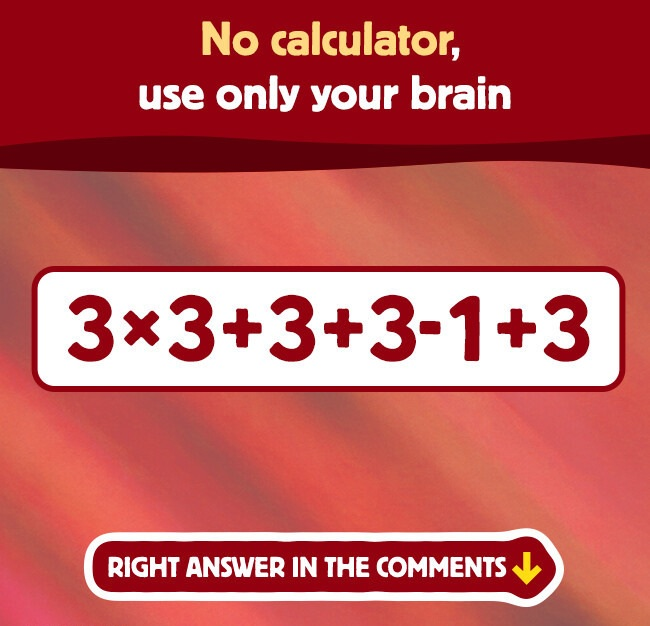Ever think your math skills could use a little warm-up? Here’s your chance to put them to the test—and have some fun while you’re at it. This isn’t just another throwaway calculation. It’s a maths brain-teaser that challenges you to think clearly, follow rules, and avoid the traps that trip up so many. The best part? You already have everything you need to solve it: your brain, your focus, and a basic understanding of arithmetic.
Let’s dive into the puzzle and see if you can find the answer without falling for the common mistakes. Trust us—most people do.

Why These Puzzles Are More Than Just Fun
Before we get to the actual math, let’s talk about why puzzles like this are so important.
Solving maths brain-teasers isn’t just a game—it’s a mental workout. These little challenges sharpen your focus, train your brain to recognize patterns, and push you to think critically. It’s the kind of skill that comes in handy way beyond the classroom. Whether you’re budgeting your expenses, analyzing a business report, or solving real-life problems, math logic builds mental discipline that pays off.
Plus, let’s face it—there’s something oddly satisfying about getting the answer right when others don’t.
video: Let these puzzles add a playful boost to your day!
The Real Challenge: Mastering the Order of Operations
This particular puzzle tests your understanding of one core concept: the order of operations. You may have learned it in school using acronyms like PEMDAS (Parentheses, Exponents, Multiplication/Division, Addition/Subtraction) or BODMAS (Brackets, Orders, Division/Multiplication, Addition/Subtraction). Either way, the rule is the same:
You must handle multiplication and division before you move on to addition and subtraction.
It sounds simple, but this is where most people go wrong. They see numbers and just start calculating left to right—ignoring the rules that keep things in order.
Let’s see how that plays out in practice.
Common Mistakes: Where Most People Go Off Track
It’s not that people don’t know how to do basic math—it’s that they rush it. And when you rush, here’s what usually happens:
- Skipping the Order of Operations: Going straight from left to right without giving priority to multiplication or division.
- Overlooking Symbols: Misreading a minus for a plus or missing a multiplication sign altogether.
- Skipping Steps: Trying to do everything in your head without writing it down or checking as you go.
Sound familiar? We’ve all done it. But the key to solving puzzles like this is slowing down and applying the rules one step at a time.
Step-by-Step Breakdown: How to Solve This Puzzle the Right Way

Let’s walk through a sample version of the puzzle, one that looks like this:
6 + 2 × 5 – 4 ÷ 2
At first glance, you might think:
“Easy! 6 + 2 is 8, times 5 is 40, minus 4 is 36, divided by 2 is 18.”
But hold up. That’s not how this works.
Let’s do it the right way, using proper maths order:
- Identify multiplication and division first:
- 2 × 5 = 10
- 4 ÷ 2 = 2
Now rewrite the expression using these results:
6 + 10 – 2
- Now move on to addition and subtraction from left to right:
- 6 + 10 = 16
- 16 – 2 = 14
Correct answer: 14
See how easy it is to go wrong if you ignore the order of operations?
Your Turn: Can You Get to 17?
Now let’s try another one. Grab a pen or just use your brain:
8 + 2 × 6 – 3 ÷ 1
Step 1: Do multiplication and division first:
- 2 × 6 = 12
- 3 ÷ 1 = 3
Now plug those in:
8 + 12 – 3
Step 2: Handle addition and subtraction:
- 8 + 12 = 20
- 20 – 3 = 17
Boom! That’s the right answer.
So if you got 17, give yourself a gold star—and share it!

Why Details Make All the Difference
You might be wondering—why all this fuss over a little puzzle?
Because the small stuff matters. In real life, overlooking one detail in a formula, financial plan, or contract can cost you. These kinds of exercises train your brain to focus, to check your work, and to apply rules consistently. They’re not just mental games—they’re life practice.
So next time you see a brain teaser online, don’t scroll past it. Take a shot. Work it through. Then double-check your answer. That one extra step could make all the difference.
The Takeaway: Think Before You Solve
The lesson here is simple: slowing down helps you speed up success. Whether you’re solving a tricky equation or making a big decision, the ability to break things down, follow structure, and catch mistakes is powerful.
Puzzles like these remind us that math isn’t about being fast—it’s about being correct.
Conclusion: Keep Challenging Your Brain
Did you crack the code and reach the answer of 17? If so, awesome work. If not, don’t sweat it—mistakes are part of learning. The key is to stay curious, keep practicing, and don’t be afraid to slow down and double-check your thinking.
Every puzzle you solve builds sharper logic, better focus, and more confidence. So keep going. There’s a whole world of brain teasers out there waiting to test you.
And next time someone says math isn’t fun, just show them your answer.


